Citroen BERLINGO 2016 2.G Service Manual
Manufacturer: CITROEN, Model Year: 2016, Model line: BERLINGO, Model: Citroen BERLINGO 2016 2.GPages: 264, PDF Size: 8.42 MB
Page 41 of 264
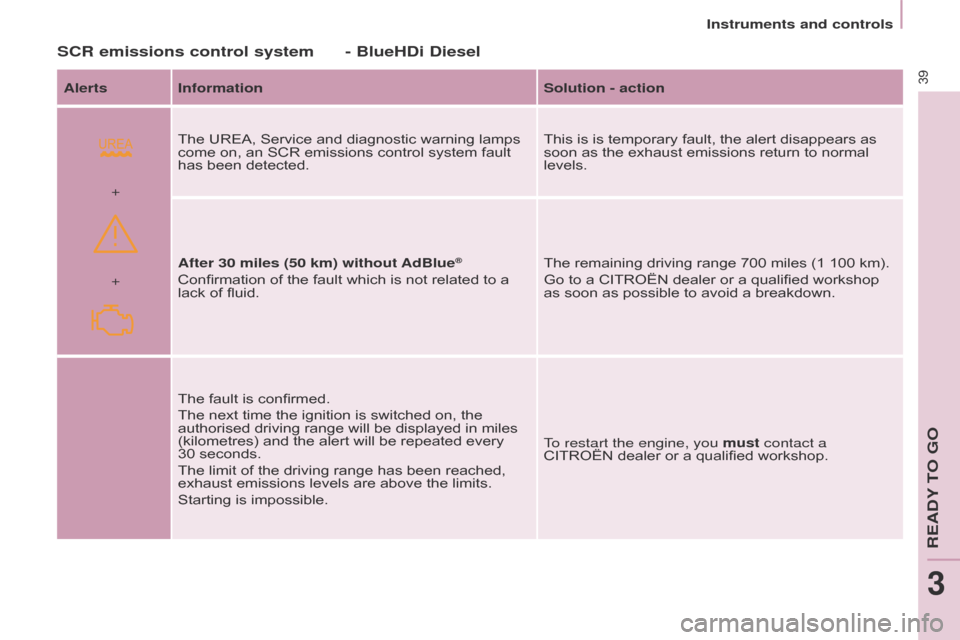
+ +
39
Berlingo-2-VU_en_Chap03_Pret-a-partir_ed01-2016Berlingo-2-VU_en_Chap03_Pret-a-partir_ed01-2016
SCR emissions control system - BlueHDi Diesel
Alerts InformationSolution - action
The UREA, Service and diagnostic warning lamps
come on, an SCR emissions control system fault
has been detected. This is is temporary fault, the alert disappears as
soon as the exhaust emissions return to normal
levels.
After 30 miles (50 km) without AdBlue
®
Confirmation of the fault which is not related to a
lack of fluid. The remaining driving range 700 miles (1 100 km).
Go to a CITROËN dealer or a qualified workshop
as soon as possible to avoid a breakdown.
The fault is confirmed.
The next time the ignition is switched on, the
authorised driving range will be displayed in miles
(kilometres) and the alert will be repeated every
30
seconds.
The limit of the driving range has been reached,
exhaust emissions levels are above the limits.
Starting is impossible. To restart the engine, you must contact a
CITROËN dealer or a qualified workshop.
READY TO GO
3
Instruments and controls
Page 42 of 264

40
Berlingo-2-VU_en_Chap03_Pret-a-partir_ed01-2016Berlingo-2-VU_en_Chap03_Pret-a-partir_ed01-2016
FUEL GAUGEC OOLANT TEMPERATURE
The needle is positioned before the
red zone: normal operation.
In arduous conditions of use or hot
climatic conditions, the needle may
move close to the red graduations.What you should do if the needle
enters the red zone:
Reduce your speed or let the engine
run at idle.
What you should do if the warning
lamp comes on:
-
stop immediately
, switch off the
ignition. The fan may continue to
operate for a certain time, up to
approximately 10 minutes,
-
wait for the engine to cool down in
order to check the coolant level and
top it up if necessary
.
As the cooling system is pressurised,
follow the procedure below to avoid the
risk of scalding:
-
wait at least one hour after
switching of
f the engine before
carrying out any work,
-
unscrew the cap by 1/4 turn to
allow the pressure to drop,
-
when the pressure has dropped,
check the level in the header tank,
-
if necessary , remove the cap to top up.
If the needle remains in the red
zone, have the system checked by
a CITROËN dealer or a qualified
workshop.
Refer to chapter 7, "Levels"
section.
Refer to chapter 7, "Fuel" section.
The fuel level is tested each time the
key is turned to the "running" position.
The gauge is positioned on:
-
1:
the fuel tank is full,
approximately 60 litres.
-
0:
the reserve is now being used,
the warning lamp comes on
continuously. The reserve when
the warning first comes on is
approximately 8 litres.
Instruments and controls
Page 43 of 264
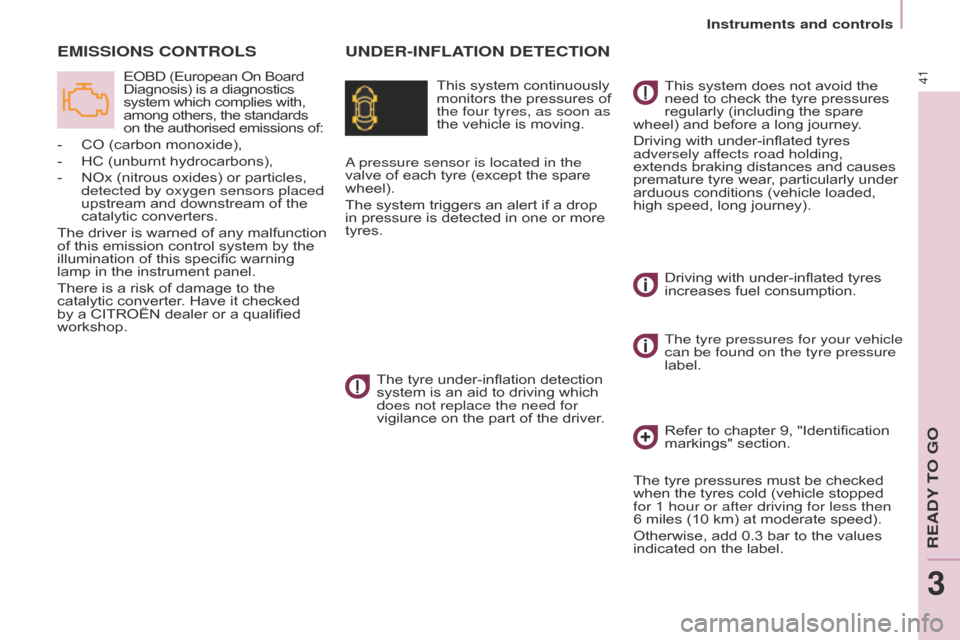
41
Berlingo-2-VU_en_Chap03_Pret-a-partir_ed01-2016Berlingo-2-VU_en_Chap03_Pret-a-partir_ed01-2016
UNDER-INFLATION DETECTIONE
MISSIONS
CONTROLS
This system continuously
monitors the pressures of
the four tyres, as soon as
the vehicle is moving.
EOBD (European On Board
Diagnosis) is a diagnostics
system which complies with,
among others, the standards
on the authorised emissions of:
-
CO (carbon monoxide),
-
HC (unburnt hydrocarbons),
-
NOx (nitrous oxides) or particles,
detected by oxygen sensors placed
upstream and downstream of the
catalytic converters.
The
driver is warned of any malfunction
of this emission control system by the
illumination of this specific warning
lamp in the instrument panel.
There is a risk of damage to the
catalytic converter. Have it checked
by a CITROËN dealer or a qualified
workshop.
a pressure sensor is located in the
valve of each tyre (except the spare
wheel).
The system triggers an alert if a drop
in pressure is detected in one or more
tyres.
The tyre under-inflation detection
system is an aid to driving which
does not replace the need for
vigilance on the part of the driver
.This system does not avoid the
need to check the tyre pressures
regularly (including the spare
wheel) and before a long journey.
Driving with under-inflated tyres
adversely affects road holding,
extends braking distances and causes
premature tyre wear, particularly under
arduous conditions (vehicle loaded,
high speed, long journey).
Driving with under-inflated tyres
increases fuel consumption.
The tyre pressures for your vehicle
can be found on the tyre pressure
label.
Refer to chapter 9, "Identification
markings" section.
The tyre pressures must be checked
when the tyres cold (vehicle stopped
for 1 hour or after driving for less then
6 miles (10 km) at moderate speed).
Otherwise, add 0.3 bar to the values
indicated on the label.
REadY To Go
3
Instruments and controls
Page 44 of 264
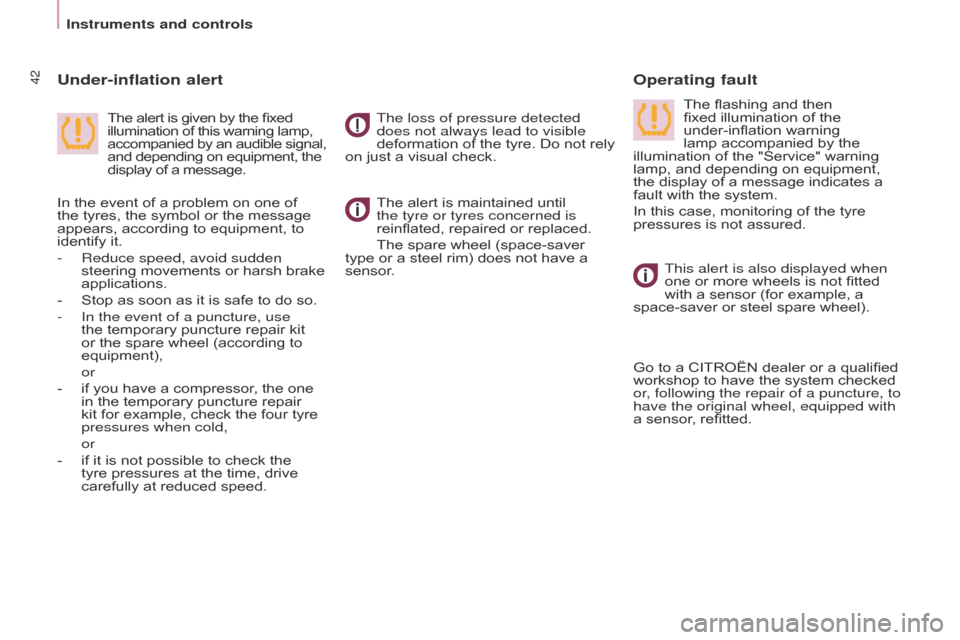
42
Berlingo-2-VU_en_Chap03_Pret-a-partir_ed01-2016Berlingo-2-VU_en_Chap03_Pret-a-partir_ed01-2016
The alert is maintained until
the tyre or tyres concerned is
reinflated, repaired or replaced.
The spare wheel (space-saver
type or a steel rim) does not have a
sensor.
Operating fault
Under-inflation alert
The loss of pressure detected
does not always lead to visible
deformation of the tyre. Do not rely
on just a visual check.
The alert is given by the fixed
illumination of this warning lamp,
accompanied by an audible signal,
and depending on equipment, the
display of a message. The flashing and then
fixed illumination of the
under-inflation warning
lamp accompanied by the
illumination of the "Service" warning
lamp, and depending on equipment,
the display of a message indicates a
fault with the system.
In this case, monitoring of the tyre
pressures is not assured.
In the event of a problem on one of
the tyres, the symbol or the message
appears, according to equipment, to
identify it.
-
Reduce speed, avoid sudden
steering movements or harsh brake
applications.
-
Stop as soon as it is safe to do so.
-
In the event of a puncture, use
the temporary puncture repair kit
or the spare wheel (according to
equipment),
or
-
if you have a compressor
, the one
in the temporary puncture repair
kit for example, check the four tyre
pressures when cold,
or
-
if it is not possible to check the
tyre pressures at the time, drive
carefully at reduced speed. This alert is also displayed when
one or more wheels is not fitted
with a sensor (for example, a
space-saver or steel spare wheel).
Go to a CITROËN dealer or a qualified
workshop
to have the system checked
or, following the repair of a puncture, to
have the original wheel, equipped with
a sensor, refitted.
Instruments and controls
Page 45 of 264

43
Berlingo-2-VU_en_Chap03_Pret-a-partir_ed01-2016Berlingo-2-VU_en_Chap03_Pret-a-partir_ed01-2016
SERVICE INDICATOR
This programmes service intervals
according to the use of the vehicle.More than 1 000 miles/km before the
next service is due
Example: 4 800 miles/km remain
before the next service is due. When
the ignition is switched on and for a
few seconds, the screen shows:
a few seconds after the ignition is
switched on, the oil level is displayed
(depending on version), then the total
distance recorder resumes normal
operation showing the total and trip
distances.
Less than 1 000 miles/km before the
next service is due
Each time the ignition is switched on and for a few
seconds, the spanner flashes and the number of
miles/kilometres remaining is displayed:
a few seconds after the ignition is
switched on, the oil level is displayed
(depending on version), then the total
distance recorder resumes normal
operation and the spanner remains on.
This indicates that a service should be
carried out shortly
.
Service overdue
Operation
A few moments after the ignition
has been switched on, the spanner
indicating a service operation comes
on; the display for the total distance
recorder gives (in round figures) the
distance remaining before the next
service.
The points at which a service is due
are calculated from the last indicator
zero reset.
The point at which a service is due is
determined by two parameters:
-
the distance travelled,
-
the time which has elapsed since
the last service. The distance remaining before the
next service may be weighted by
the time factor
, depending on the
type of driving. With the engine running the spanner
remains on until the service has been
carried out.
For BlueH
d i d iesel versions, this
alert is also accompanied by the fixed
illumination of the Service warning
lamp, on switching on the ignition. Each time the ignition
is switched on and for a
few
seconds, the spanner
flashes and the excess
distance is displayed.
For BlueH
d i d iesel versions, the
spanner can also come on early,
according the level of deterioration
of the engine oil. Deterioration of the
engine oil depends on the conditions of
use of the vehicle.
READY TO GO
3
Instruments and controls
Page 46 of 264
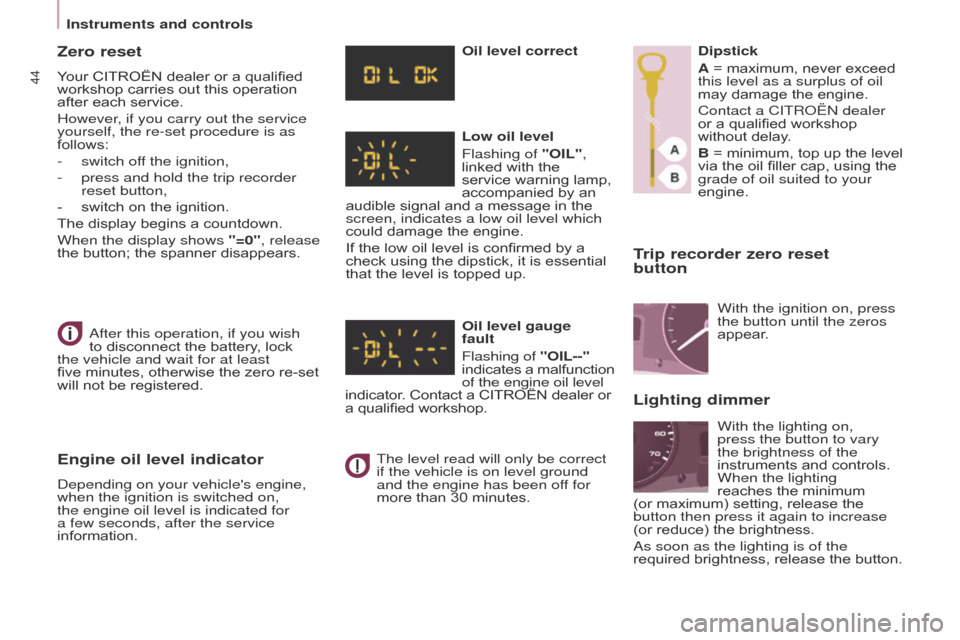
44
Berlingo-2-VU_en_Chap03_Pret-a-partir_ed01-2016Berlingo-2-VU_en_Chap03_Pret-a-partir_ed01-2016
Trip recorder zero reset
button
after this operation, if you wish
to disconnect the battery , lock
the vehicle and wait for at least
five
minutes, otherwise the zero re-set
will not be registered.
Zero reset
Your CITROËN dealer or a qualified
workshop carries out this operation
after each service.
However, if you carry out the service
yourself, the re-set procedure is as
follows:
-
switch of
f the ignition,
-
press and hold the trip recorder
reset button,
-
switch on the ignition.
The display begins a countdown.
When the display shows
"=0", release
the button; the spanner disappears.
Engine oil level indicator
depending on your vehicle's engine,
when the ignition is switched on,
the engine oil level is indicated for
a few
seconds, after the service
information. Oil level correct
Low oil level
Flashing of "OIL",
linked with the
service warning lamp,
accompanied by an
audible signal and a message in the
screen, indicates a low oil level which
could damage the engine.
If the low oil level is confirmed by a
check using the dipstick, it is essential
that the level is topped up.
Oil level gauge
fault
Flashing of "OIL--"
indicates a malfunction
of the engine oil level
indicator. Contact a CITROËN dealer or
a qualified workshop.
The level read will only be correct
if the vehicle is on level ground
and the engine has been off for
more than 30 minutes. Dipstick
A = maximum, never exceed
this level as a surplus of oil
may damage the engine.
Contact a CITR
o Ë n dealer
or a qualified workshop
without delay.
B = minimum, top up the level
via the oil filler cap, using the
grade of oil suited to your
engine.
With the lighting on,
press the button to vary
the brightness of the
instruments and controls.
When the lighting
reaches the minimum
(or maximum) setting, release the
button then press it again to increase
(or
reduce) the brightness.
a
s soon as the lighting is of the
required brightness, release the button. With the ignition on, press
the button until the zeros
appear.
Lighting dimmer
Instruments and controls
Page 47 of 264
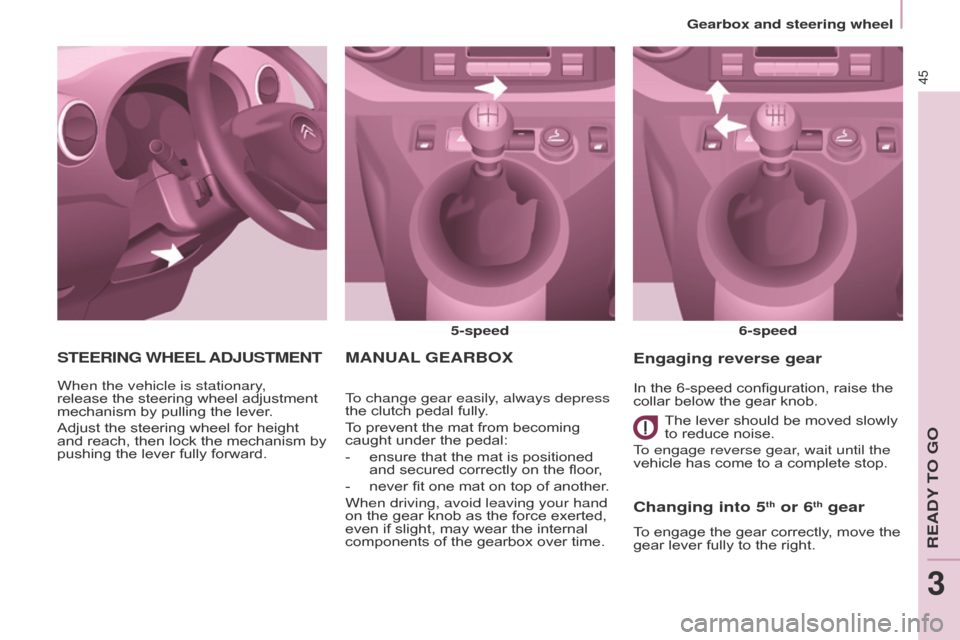
45
Berlingo-2-VU_en_Chap03_Pret-a-partir_ed01-2016Berlingo-2-VU_en_Chap03_Pret-a-partir_ed01-2016
MANUAL GEARBO x
5-speed
6-speed
To change gear easily, always depress
the clutch pedal fully.
To prevent the mat from becoming
caught under the pedal:
-
ensure that the mat is positioned
and secured correctly on the floor
,
-
never fit one mat on top of another
.
When driving, avoid leaving your hand
on the gear knob as the force exerted,
even if slight, may wear the internal
components of the gearbox over time.
Changing into 5th or 6th gear
To engage the gear correctly, move the
gear lever fully to the right. In the 6-speed configuration, raise the
collar below the gear knob.
Engaging reverse gear
S
TEERING
WHEEL
ADJUSTMENT
When the vehicle is stationary,
release the steering wheel adjustment
mechanism by pulling the lever.
Adjust the steering wheel for height
and reach, then lock the mechanism by
pushing the lever fully forward. The lever should be moved slowly
to reduce noise.
To engage reverse gear, wait until the
vehicle has come to a complete stop.
READY TO GO
3
Gearbox and steering wheel
Page 48 of 264
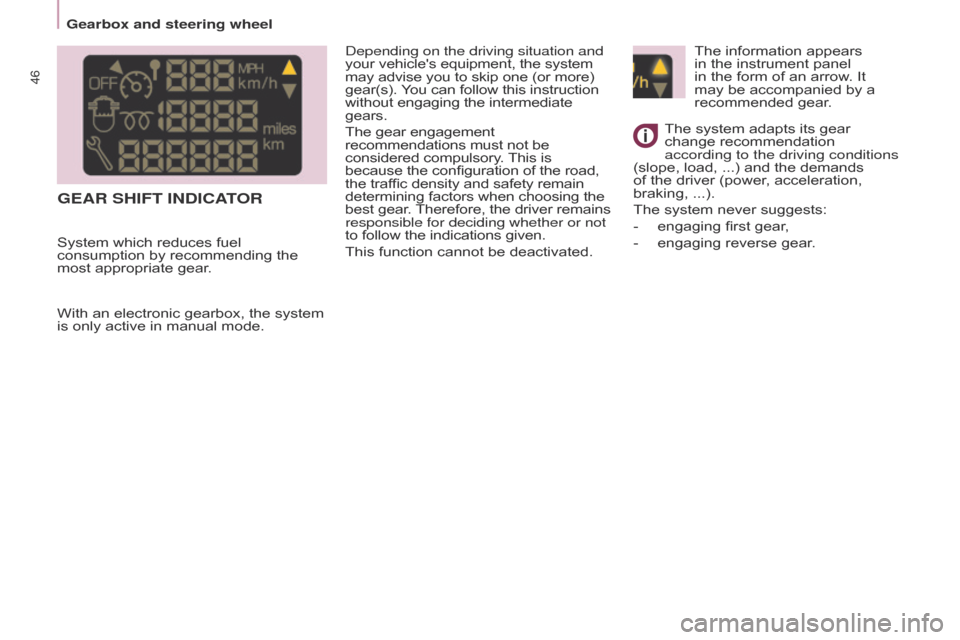
46
Berlingo-2-VU_en_Chap03_Pret-a-partir_ed01-2016Berlingo-2-VU_en_Chap03_Pret-a-partir_ed01-2016
GEAR SHIFT INDICATOR
depending on the driving situation and
your vehicle's equipment, the system
may advise you to skip one (or more)
gear(s). You can follow this instruction
without engaging the intermediate
gears.
The gear engagement
recommendations must not be
considered compulsory. This is
because the configuration of the road,
the traffic density and safety remain
determining factors when choosing the
best gear. Therefore, the driver remains
responsible for deciding whether or not
to follow the indications given.
This function cannot be deactivated.
With an electronic gearbox, the system
is only active in manual mode. The system adapts its gear
change recommendation
according to the driving conditions
(slope, load,
...) and the demands
of the driver (power, acceleration,
braking,
...).
The system never suggests:
-
engaging first gear
,
-
engaging reverse gear
.
The information appears
in the instrument panel
in the form of an arrow. It
may be accompanied by a
recommended gear.
System which reduces fuel
consumption by recommending the
most appropriate gear.
Gearbox and steering wheel
Page 49 of 264
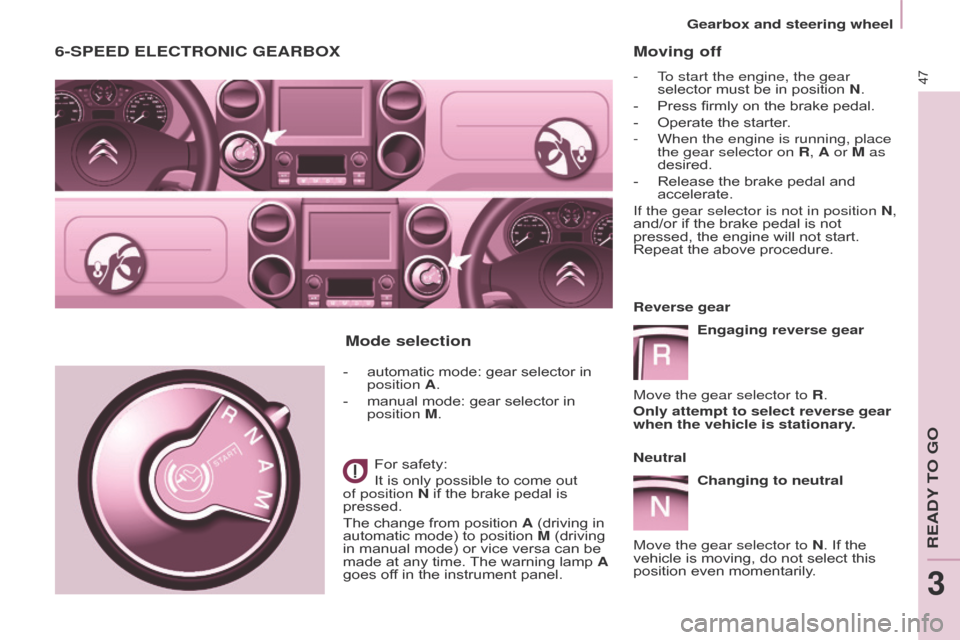
47
Berlingo-2-VU_en_Chap03_Pret-a-partir_ed01-2016Berlingo-2-VU_en_Chap03_Pret-a-partir_ed01-2016
Moving off
- To start the engine, the gear selector must be in position N.
-
Press firmly on the brake pedal.
-
Operate the starter
.
-
When the engine is running, place
the gear selector on
R, A or M as
desired.
-
Release the brake pedal and
accelerate.
If the gear selector is not in position
N,
and/or if the brake pedal is not
pressed, the engine will not start.
Repeat the above procedure.
Reverse gear
Engaging reverse gear
Move the gear selector to R.
Only attempt to select reverse gear
when the vehicle is stationary.
Neutral Changing to neutral
Move the gear selector to N. If the
vehicle is moving, do not select this
position even momentarily.
6-SPEED ELECTRONIC GEARBOx
- automatic mode: gear selector in
position A.
-
manual mode: gear selector in
position
M.
For safety:
It is only possible to come out
of position N if the brake pedal is
pressed.
The change from position A (driving in
automatic mode) to position M (driving
in manual mode) or vice versa can be
made at any time. The warning lamp A
goes off in the instrument panel.
Mode selection
READY TO GO
3
Gearbox and steering wheel
Page 50 of 264
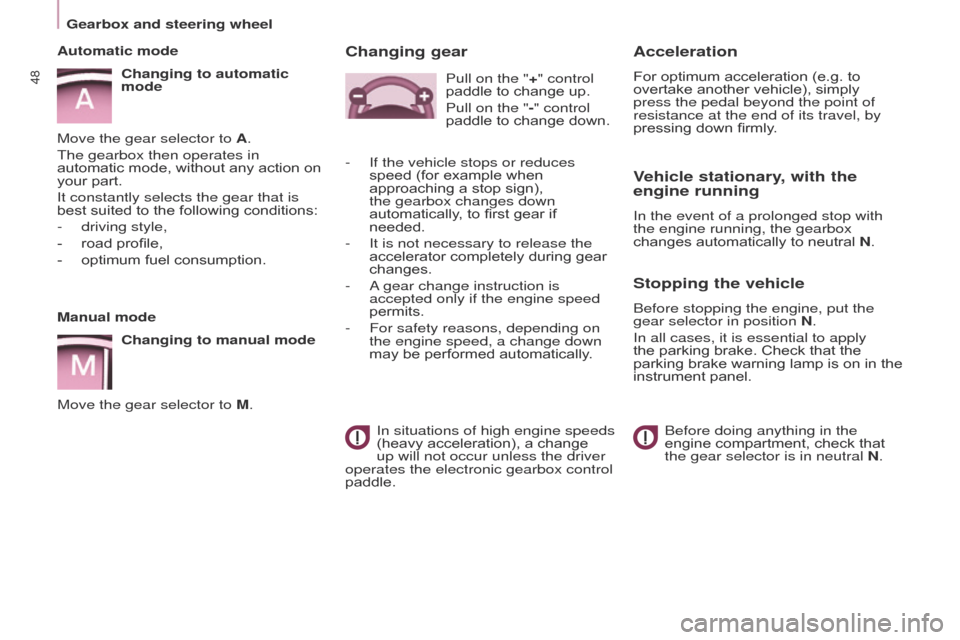
48
Berlingo-2-VU_en_Chap03_Pret-a-partir_ed01-2016Berlingo-2-VU_en_Chap03_Pret-a-partir_ed01-2016
Manual modeChanging to manual mode
Move the gear selector to M.
Automatic mode
Changing to automatic
mode
Move the gear selector to A.
The gearbox then operates in
automatic mode, without any action on
your part.
It constantly selects the gear that is
best suited to the following conditions:
-
driving style,
-
road profile,
-
optimum fuel consumption.
Vehicle stationary, with the
engine running
In the event of a prolonged stop with
the engine running, the gearbox
changes automatically to neutral N.
Stopping the vehicle
Before stopping the engine, put the
gear selector in position N.
In all cases, it is essential to apply
the parking brake. Check that the
parking brake warning lamp is on in the
instrument panel.
Before doing anything in the
engine compartment, check that
the gear selector is in neutral N.
Acceleration
For optimum acceleration (e.g. to
overtake another vehicle), simply
press the pedal beyond the point of
resistance at the end of its travel, by
pressing down firmly.
Changing gear
In situations of high engine speeds
(heavy acceleration), a change
up will not occur unless the driver
operates the electronic gearbox control
paddle. Pull on the "+"
control
paddle to change up.
Pull on the "-" control
paddle to change down.
-
If the vehicle stops or reduces
speed (for example when
approaching a stop sign),
the gearbox changes down
automatically
, to first gear if
needed.
-
It is not necessary to release the
accelerator completely during gear
changes.
-
a
gear change instruction is
accepted only if the engine speed
permits.
-
For safety reasons, depending on
the engine speed, a change down
may be performed automatically
.
Gearbox and steering wheel